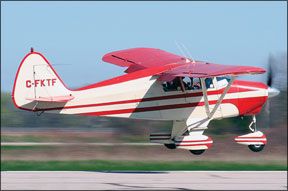There was a time when almost all light airplanes were taildraggers. Tricycle-gear airplanes were rare, mainly because taildraggers-or conventional-gear airplanes, if you prefer-generally were better at dealing with the unpaved runways at most airports. This common kinship among light airplanes continued into the early 1950s, broken only by such types as the Ercoupe, Navion and Beech Bonanza, to pick
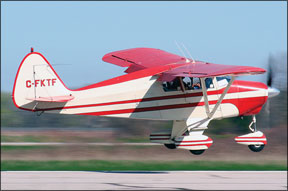
three.
Up at Lock Haven, Pennsylvania, in the late 1940s, the Piper Aircraft Corporation was making a wide range of airplanes, including the venerable Cub, mostly of fabric stretched over a wood or metal frame. Out in Wichita, Cessna and Beech were only beginning their transition to all-metal airplanes with tricycle gear, which must have made for some sleepless nights at Piper. While the company apparently couldnt develop an all-metal airplane overnight, it could convert its four-seat, conventional-gear Pacer to the tricycle-gear configuration ahead of many others.
The result, which the company unimaginatively dubbed the Tri-Pacer, is not what one would call a modern-looking airplane, even for the early 1950s. Short-coupled, with stubby, strut-braced, high-mounted wings and thick-looking tricycle landing gear, the tube-and-fabric four-seater seems more than a bit dowdy today. Nicknames bestowed upon it-like Flying Milk Stool, Slow-Pacer, Flying Brick and Three-Legged Hog-reflect its silhouette. But the airplanes looks gave way to owners delight at the airplanes pleasing mix of reasonable performance and load-carrying capability combined with low purchase prices and rock-bottom operating costs.
And theyve got a point. The Tri- Pacer can cruise faster than a vintage Cessna 172 on only seven to nine GPH. It has good short-field perfor mance, a wide CG range and good parts availability to boot. The price for this ranges from about $15,000 up to around $20,000 or so, though a “fixer-upper” can be had for less. Thats a pretty good value, if the prospect of being snickered at doesnt bother you. Its a steal if youre into vintage machines and prefer watching your wallet instead of making sure you have the latest and greatest.
History
In a way, the Tri-Pacer defined a whole new market niche, one eventually dominated by Cessnas Skyhawk. Introduced for the 1951 model year, Pipers PA-22-125 Tri-Pacer was based on the PA-20 Pacer, itself only a year old and an upgrade of earlier models. Because of those roots, its possible and popular to convert a Tri-Pacer back to taildragger configuration with an STC. Interestingly, the PA-20 is, to our eye, more aesthetically pleasing than the Tri-Pacer. Amazing what that nose gear can do.
The Tri-Pacer was a great success back in the heady 1950s. During the airplanes nine-year production run, more than 7600 were built. But in 1956, Cessna introduced the world-beating 172, which outsold the Tri-Pacer so badly that production was stopped in 1960.
The first Tri-Pacers had 125-HP Lycoming O-290-D engines, which were changed halfway through the second year of production to 135-HP -D2 models (PA-22-135). In 1955, that engine was swapped out for a 150-HP Lycoming O-320-A1A (PA-22-150) . In 1958, the 160-HP O-320-B2A was offered as an option, giving a boost in useful load and changing the model designation to PA-22-160. The latter engine can be retrofitted with an STC; a worthwhile mod at overhaul. From 1958 through 1960, the PA-22-150 Caribbean-a less well-equipped Tri-Pacer-also was offered. Aside from this, there were no significant changes during the Tri-Pacers production run. Floats were offered as an option for the PA-22S seaplane version, as were 44-gallon tanks after 1955.
Despite ending Tri-Pacer production in 1960, Piper kept the marque alive with the Colt, which competed against Cessnas 150. Powered by a 108 HP Lycoming O-235-C1B, the Colt only saw three years of production, which ended in 1963. Some 1800 PA-22-108 Colts were produced.
Accommodations
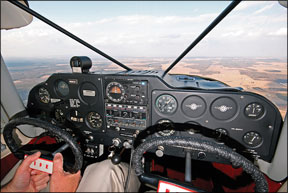
Despite two doors (one on the right front for the front seats, one on the left rear for the back seats), the Tri-Pacer is tough to climb into-perhaps a bit of its taildragger heritage showing through. The gear is relatively tall, making for a long climb up, and the doors are small due to the need to clear some of the fuselage tubes.
Once inside, some passengers find the Tri-Pacer cramped and dark. Two wide people sitting side-by-side should be very good friends, at least. As one owner put it several years back, “The Tri-Pacer is built for people who are either small, or who are willing to become good friends.
Built to Last
Tri-Pacer construction is fairly sturdy. Steel tubing covered with fabric was the factory standard, and in terms of strength and lightness it does well. But all-metal airplanes soon became the state of the art. As a result, “metalizing” became a popular mod for fabric-covered airplanes like the Tri-Pacer. However, it seems most owners have been able to resist the urge to get their airplanes converted to spam-cans. Most Tri-Pacers are still fabric covered.
The fabric holds up we’ll according to most owners, especially the Ceconite and Razorback coverings. Some might say they last too long, allowing corrosion to progress undetected for a long time. Although Razorback can last more than 20 years, the structure underneath may rot away in only 10 years. Some owners, opting for safety, get their bird recovered every 10 years, whether it needs it or not.
Even with regular inspections and recovering, the steel-tube structure of the Tri-Pacer is somewhat susceptible to corrosion. One trouble area is the tubing around and under the doors. Another seems to be the tail surfaces, especially the stabilizer. Several owners report finding rust in the lower longerons and tail-section tubing.
The lift struts are another nettlesome component. Internal corrosion is a well-known problem, as is cracking of the strut forks (well discuss these further, shortly). Otherwise, owners report maintenance offers no special problems, and upkeep costs are quite low. A scan of a six-year printout of FAA Service Difficulty Reports (SDRs) showed few real trends. In fact, only one other problem besides the aforementioned corrosion turned up with any regularity. That involved the starter cables. Slow cranking, and eventually, burned wires were cited in 10 reports, ranging through all models. Replacement at the first signs of reduced cranking power seems to be the order of the day here.
Despite its rather dated looks, the Tri-Pacer is a surprising performer, and earns high marks from owners in this regard. Except for the lower-powered models, most Tri-Pacers can lift three adults, a smidgen of baggage and full fuel-and still manage a decent climb rate. And while stubbiness usually translates into a small loading envelope, owners report that its almost impossible to get the CG too far forward or aft. (But its quite possible to overload.)
Its got good short- and soft-field performance, provided the field isn’t too high or hot. But even then, the Tri-Pacer can hack it if the load is kept light, particularly with the higher-horsepower models. One owner told us he uses his Tri-Pacer to routinely fly over 9000-foot mountains in the west.
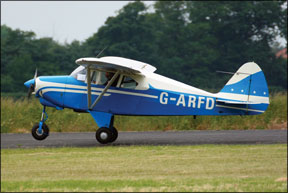
Owners report cruise speeds in the 120- to 130-MPH range at middling altitudes (6000 to 7000 feet). This is comparable to a Piper Cherokee or even a Warrior. Maximum altitude is also very good, with climb performance petering out at about 13,000 feet as engine power bleeds away.
The low-power models are another story, though. don’t expect to carry four people and more than an hour of fuel, because the airplane may not make it off the ground. The low-power models can make fine Sunday fliers, but don’t consider them as cross-country, load-toting machines.
Landing can be a dicey affair, judging by the aircrafts accident history. The Tri-Pacers stubby wings mean getting slow on final can produce prodigious sink rates (as high as 2000 FPM, according to one owner). This may be why the Tri-Pacer has a reputation for gliding like the proverbial brick. To those who arent familiar with the airplane, the insidious onset of a high sink rate on final can be unnerving (and lead to undershooting the runway). A key is to nail the speed (68-70 MPH) and carry power. As one owner notes, “You pull the power back, and she lands.”
Once the airplane is on the runway, the short fuselage and narrow landing gear can make for somewhat nervous manners. Swerves that are mild in other aircraft can be hair-raising in a Tri-Pacer. Hand-operated brakes don’t help here, either. This leads to one of the Tri-Pacers few problems-ground handling. Strong winds can be a real hazard for this airplane. Its stance on the ground and its high wing are almost an invitation to get blown over. And taxiing is no tea party, either. Fast turns can spell disaster, as can turns from a headwind into a crosswind. Make a sharp, snappy turn off the runway with a strong wind, and remaining upright can be a real challenge.
But once its off the ground, the Tri-Pacer can be a delight to fly. Controls are we’ll harmonized, and an aileron-rudder interconnect gives the pilot the choice of making turns with feet off the rudder or hands off the yoke. Pilots report the interconnect is easy to overpower for slips.
While its close-coupled, the Tri-Pacer is surprisingly stable, perhaps because of the stubby wings resulting in a relatively higher wing loading when compared to other types. Although it will bounce around in turbulence, it doesnt wander or hunt up and down. It wont fly hands-off, but it wont try to swap ends, either.
Another surprise is stall behavior. Many pilots report that the Tri-Pacer wont stall in the classic sense. Haul back on the yoke and the nose comes up, the airspeed goes down and the airplane soon starts to sink. But it never breaks or pitches over-it just sinks. However, “correctly” mishandled, the Tri-Pacer can raise the adrenaline of even hardened pilots. It definitely will stall and spin if not flown properly.
AD Scene
Considering its age, the Tri-Pacer has fared very we’ll in terms of ADs. Most were of the one-time sort and should have been complied with long ago.
There is a significant AD on the wing struts, AD 99-01-05, which supersedes AD 93-10-06 (which itself once was two ADs, 77-03-08 and 81-25-05). Part of the AD calls for inspecting the struts for corrosion and dents every 24 months, as we’ll as treating them with a corrosion inhibitor. The other part of the AD addresses the lift-strut forks. According to the AD, the original machined-thread forks were prone to fatigue cracking. The fatigue apparently originated at the bottom of the thread grooves, which were sharp. The problem was exacerbated by people using the struts as steps when ingressing and egressing.
The AD calls for immediate inspection of the forks using “magnetic particle procedures” to detect cracks every 500 hours. If no cracks were found, then the forks could be returned to service if they had less than 2000 hours on them (1,000 hours for floatplanes or any plane that had been on floats at any time in its life).
But at 2000 hours (or 1000), the forks have to be replaced with rolled-thread types using parts available from Piper or other vendors and installed under an STC. Applying an STC for installation of aftermarket struts and/or fork terminates that portion of the AD. Also a “no-step” placard must be installed. Buyers shopping for a Tri-Pacer and finding one advertised as low time should make sure the AD has been complied with or the forks replaced.
Resale Value
Like most airplanes, the Tri-Pacer steadily gained value in past years. These days, along with the rest of the fleet, prices are relatively flat, with $15-20,000 being the high/low range for the various Tri-Pacer models, same as it was several years ago. Nevertheless, the plane is still a relative bargain, given its capabilities. At those prices, its about the cheapest four-seat around.
For example, a 1958 PA-22-150 was selling for $6750 back in 1978. Today, that same airplane is worth about $19,000. On the face of it, the airplane has more than doubled in value. But when inflation is taken into account, the real gain is somewhat less. In fact, the gain in the Tri-Pacers value has barely kept pace with inflation. In current dollars, the airplanes value has not changed much. Still, you wont be losing money by investing in one.
Buyer Points
Besides all the usual items buyers should look for, the Tri-Pacer has some peculiarities to be aware of. However, any mechanic worth his hourly rate (and familiar with the airplane) should catch most of them.
Of course, the airplanes AD compliance history should be carefully examined. While few of the airplanes ADs have been really serious, there are at least three that are genuine safety-of-flight items. Besides the aforementioned strut ADs, the third important one calls for reinforcement of the fabric over the windscreen. In several accidents, the fabric became loose and lifted up. The ballooning fabric acts like a big air scoop and spoiler, creating incredible drag and destroying airflow over the tail surfaces. This can make control just about impossible, and level flight out of the question.
The age and overall condition of the fabric is another consideration. A fresh covering job may indicate an attempt to cover up expensive structural problems (like rusted tubing). On the other hand, fabric thats more than 10 years old could be doing the same.
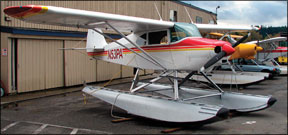
The Tri-Pacer is no stranger to brake failures, so a careful check of the condition and history of the brakes is in order. Considering that the brakes are operated by a single hand lever (pressurizing two separate master cylinders), failure can make for some dramatic moments during landing. Look for recent (i.e., within the last 10 years) replacement of the diaphragms and drum turning to ensure long-lasting, reliable brakes. Another item to look for is half-inch exhaust valves in the O-320 engines. With the valves, TBO is a healthy 2000 hours. Without, its only 1200. The Colts 108-HP engine comes with a whopping 2400-hour TBO.
Mods, Organizations
There are mods a-plenty for the Tri-Pacer. Owners can get everything from the mundane to the radical for their airplane. One worth looking into gets rid of the old drum-type brakes and installs disk brakes. Another adds toe brakes. If a prospective purchase still has drum brakes, a buyer might want to look into Univairs brake STC.
Some owners are turning their Tri-Pacers back into Pacers by removing the nose gear and moving the mains forward. It improves the airplanes looks considerably, but brings with it taildragger ground handling foibles. Univair also holds an STC for this.
Perhaps the best mod is a simple engine swap, from the increasingly rare O-290 to the quite-common Lycoming O-320, or even a 180-HP O-360. Available Tri-Pacer STCs also include operation on automobile gasoline, replacing the fabric covering with metal skins, skis, shoulder harnesses and tundra tires, along with the usual avionics and instrumentation upgrades.
Owners weve heard from almost universally noted Univair as their main source of parts. In addition to holding several STCs (including one to replace the wing ribs with stamped aluminum ones), Univair stocks many hard-to-get parts. Availability has not proven to be a problem. Thats a key consideration in an airplane this old. Membership in the Short Wing Piper Club (www.shortwing.org) is a must for Tri-Pacer (and other early Piper) owners. As a source of current news, maintenance tips and owner information, the club cant be beat. Theyre located in Halstead, Kansas, and can be reached at 316-835-3650.
Owner Comments
I always wanted my own plane from the time I was a kid. Im 63. Finally I could afford one last year. I always liked the Tri-Pacer but had never been in one; I just liked the looks! I bought one in June 2007, a 1959 150 with about 2500 hours on the airframe and 500 SMOH on the engine and the original drum brakes.
Shes a sweetheart, handling better than the 172s Im used to. The Tri-Pacer is faster and will carry more weight than a comparable 172. The only point that rang true from the stories was landing.
You have to fly a Tri-Pacer on, then plant the nose gear. If you try to flare like 172 those short wings just give up and youd better have the hook down and hope you get the three wire because that thing is coming down right now. I did some pretty good carrier landings getting used to its habits. The Tri-Pacer will bounce real good on grass as we’ll as pavement!
I lost my first PA-22 five months after its purchase in a too-long, too-fast gusty crosswind on my 1700-foot, downhill airport and put her on her back in a plowed corn field. She has been replaced by a 1957 PA-22-150 that I flew home yesterday.
I can fly my PA-22 for about $110 an hour, including maintenance (Im an A&P-IA), hangar, insurance, gas and oil. I paid $148 an hour wet to rent the 172s I flew with my club, not including insurance and club dues.
Bill Cameron
West Houston, Texas

